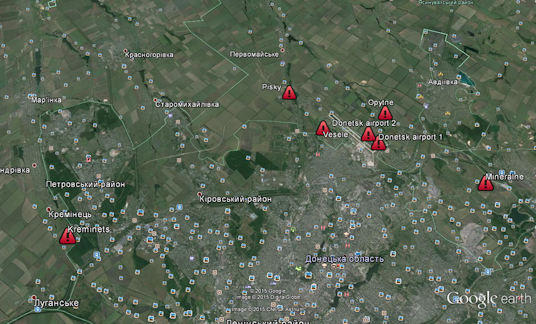International charitable organization “Environment-People-Law” (EPL) continues studying the impact of military actions in Eastern Ukraine on the environment. EPL environmentalists study the changes in the environment, in particular in soils, concentrations of mobile forms of heavy metals that can migrate into plants and human organisms, and unsolvable forms of metals.
With the help of volunteers soil samples were taken in the hottest spots of shell explosions in Donetsk and in the vicinity of Donetsk, namely in the settlements of Pisky, Opytne, Mineralne in Yasynuvata district, Kreminets in Maryinka district, Vesele in Volodarske district and in Donetsk airport.

Thousands of exploded shells and bombs, the use by aggressors and terrorists of weapons of unknown origin make us conduct thorough studies because the damage caused to the environment will be felt by many future generations, – says the Executive director of EPL Olena Kravchenko.
In all analyzed explosion craters with the exception of those in the village of Pisky we revealed excessive levels of mobile forms of heavy metals – manganese, copper, iron, lead, cadmium, chromium and zinc. Consolidated samples were taken from the sites of craters, in each settlement background samples were taken 4 meters from craters to eliminate the factor of natural dissemination of the above mentioned microelements, – says EPL environmentalist Alla Voytsykhovska.
Excessive levels of mobile forms of lead were revealed in the villages of Kreminets (8,2 times), Opytne and Donetsk airport (1,8 times), Vesele (1,6 times). In the village of Mineralne the level of cadmium exceeds the background concentration by 2,5 times and in Donetsk airport – by 12 times. Excessive concentration of zinc was revealed only in the village of Opytne, in this crater there was also revealed maximum concentration of iron (exceeding the norm by 10,8 times), manganese (by 3,3 times), copper (by 2,4 times) and chromium (by 1,9 times).
Insignificant deviations from background concentrations were revealed for manganese in the village of Vesele and Donetsk airport and for copper in the village of Mineralne (by 1,3 times).
EPL also analyzed samples from craters in the above mentioned settlements with the aim to reveal unsolvable forms of heavy metals.
Only the sample taken in the Village of Pisky in Yasynuvata district does not show any excessive levels of metals. All other samples show excessive levels of the following metals: manganese, tin, chromium, helium, nickel, vanadium, titanium, copper, yttrium, zirconium, cobalt and strontium.
The highest concentrations were recorded in Donetsk (sample 1) for gross content of manganese (exceeding the norm by 3,2 times), there were excessive levels for nickel (by 3,1 times), vanadium (by 2,8 times) and copper (by 2,4 times) in the village of Vesele, for chromium and cobalt more than by 3 times, zirconium (by 1,4 times), vanadium (by 2,5 times) and strontium (by 1,5 times) in the village of Opytne in Yasynuvata district. Insignificant excess for chromium was detected in Donetsk airport (sample 2) – by 1,3 times.
In the village Mineralne in Yasynuvata district the concentration of the rare earth metal yttrium exceeds background concentrations by 2,9 times. Exceeding concentrations of tin (by 2,8 times) were recorded in the village of Kreminets in Maryinka district. Tin can be one of the components of alloy with titanium. The same sample from a crater showed exceeding levels of manganese (by 1,6 times), chromium (by 2,1 times), gallium (by 2 times), nickel and titanium (by 1,4 times), copper (by 1,5 times), zirconium (by 1,2 times), cobalt (by 2,5 times).
Excessive gross concentrations of heavy metals that were detected are presented in the pictures below.
Considering the fact that various types of armament may contain phosphorus, we analyzed gross content of phosphorus in all samples, – says EPL environmentalist Kateryna Norenko. EPL revealed excessive levels of phosphorus in the samples taken in Kremenets (by 4 times), Mineralne (by 1,5 times), Vesele (by 4,5 times), and in Donetsk airport (sample 1) by 1,8 times in comparison with background concentrations, – adds Alla Voytsikhovska.
Such a spectrum of chemicals and their excessive concentrations on the sites of shell explosions prove that soils in the vicinity of Donetsk where military actions took place are polluted. Mobile forms of heavy metals will migrate into living organisms causing adverse impact on the environment and human health. Heavy metals remain in the environment for hundred years and their excessive concentrations are extremely harmful for human health.
EPL studied non-organic substances but shell explosions can also cause emission of organic substances that can travel for long distances via air and water ways. The adverse impact will be felt by many generations and this relates to both parties to the conflict.
Environmentalists will continue studying the impact of military actions on the environment in Eastern Ukraine. Let’s stop the devastation of living things together!
For further information please contact:
Olena Kravchenko, EPL Executive director
Email: okravchenko@epl.org.ua, tel.: (032) 225 – 76 – 82
Alla Voytsikhovska, EPL environmentalist of the 1st category
Email: alla.voytsyhovska@gmail.com, tel.: (032) 225 – 76 – 82
Kateryna Norenko, EPL environmentalist
Email: kateryna.norenko@gmail.com, tel.: (032) 225 – 76 – 82

